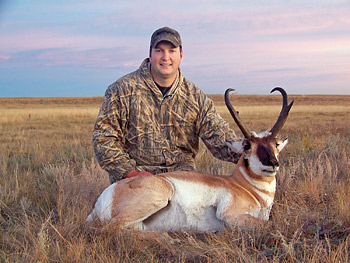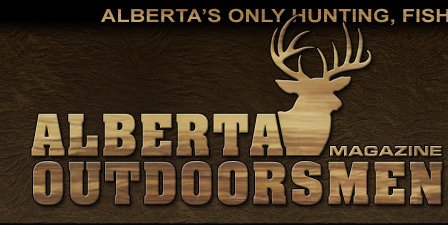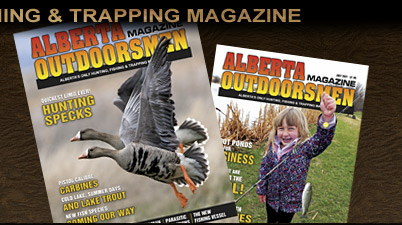|
 |
It all started in June of 2008 when I received my copy of the 2008 Alberta Hunting Draws booklet. I had a priority 4 for archery antelope and a 6 for the trophy draw. I knew I didn’t have enough priority for the trophy so I put in 999 and really started to practice with my archery gear in the hopes of drawing the archery tag. I couldn’t wait for the results in the mail so I immediately called the draw results line when they were made available, and sure enough I was drawn.
Since I live in close proximity to the area I intended to hunt, pre-season scouting wasn’t an issue. I saw plenty of the prairie speedsters and was eagerly awaiting the September rut in hopes to have an opportunity to take one of North America’s fastest land animals.
Opening day came and I was on my quest to harvest any legal buck that presented an opportunity. I didn’t have any particular buck in mind; I just wanted to say that I shot one with my bow.
Well, opening day came and went with no luck, however, later in the season I was again able to get out and the bucks really started responding to the decoy. I had plenty of decent bucks come into my setup only to have them circle me downwind and bolt out of there as fast as they came in. In one attempt I had a buck that was feeding with his harem of five does about 150 yards away. He saw the decoy and before I could attach my release and look up for him, he had already run past me and was on his way back to his does. I couldn’t believe how fast he was. I knew the way he responded to the decoy that it would only be a matter of time before I was able to get my first archery antelope.
The following day I headed to the field after work and spotted a buck with a single doe. Figuring he would defend his territory as well as his prized female, I decided to go after him. With the prairie wind in my face, I silently crept over the hill that was between my quarry and me. When I came to the crest of the hill, I knocked an arrow and slowly lifted the decoy and watched as the buck cautiously came to me. He slowly made his way to my right and offered a perfect broadside shot. I drew back, placing my 40 yard pin on his chest, and released only to watch the arrow slip over his back and hear the snorts of the angered buck return to his doe. They both looked at me and bolted away leaving only a trail of dust. To my disappointment I figured that was going to be my one chance of successfully harvesting an antelope and I totally blew it by incorrectly judging the distance.
I went home that night in total disgust, “How could I miss?” I asked myself. “He was right there, broadside, not skittish at all,” I said to my wife as though looking for sympathy. She didn’t give me any sympathy but she did give me some encouragement and told me to keep trying.
By now it was the last week of September and the aggressive nature of the rutting bucks was coming to a halt. I knew that my chances at decoying a buck were low and a new technique would have to be implemented to get my antelope. I was going to try some spot and stalk. This was going to be a challenge with the limited cover of the short grass prairie, but it was my only option.
 |
| Nathan and his 2009 trophy antelope. |
I headed out one evening and came across another buck and doe combo. I quickly glassed them over and determined he was a legal buck. Once again I circled downwind and slowly started to approach the two feeding animals. I wasn’t even within 100 yards when the buck turned his head and stared at me with his enormous eyes. Luckily for me the doe was feeding behind a hill and he was reluctant to leave her. I kept creeping closer and closer. I had to make up more ground, as I was only comfortable with my bow to 40 yards. I ever so slowly kept taking one step at a time thinking that the doe would bust me with the crunching sound of the dry prairie grass. I saw the buck flair his white rump; the telltale sign that he was about to put it in high gear. I quickly ranged him and to my surprise he was only 35 yards. I drew back and watched as my arrow entered his chest.
The red patch on his tan hide confirmed it was a good shot. He took off running and made a complete circle before falling not 20 yards from where I had shot him. Finally, my archery antelope was down with only three days left before the start of the trophy rifle season.
The buck green scored 56 2/8.
Fast forward a year and it was time to enter the Alberta draws again. But this time I had a priority 7 for antelope, and when looking back at the 2008 draw summary report, I figured I had a chance of drawing a tag.
Once again I couldn’t wait until I received the letter in the mail. Only this year the results came early on the AlbertaRELM website. I was drawn again, but this time for trophy antelope.
One week before the season opener I started spending more time in the field scouting and glassing several bucks to try and get a handle on field judging these animals. I found it very difficult to tell the difference from a nice one to a true trophy and I was almost going crazy trying to determine which one was the best. Two days before the season I spotted the buck I wanted. He wasn’t the tallest I had seen but he had a little of everything; average height, good mass all the way to the tips and decent cutters.
Sunday afternoon I went back to where I had seen him the day before and sure enough he was there along with eight does. My brother and I put him to bed that night, ensuring we would know where he was on opening day.
We arrived to our spot 30 minutes before legal shooting time and anxiously waited for enough daylight to start glassing. Just as the sun was starting to crest over the prairie landscape, my brother spotted one of the does feeding in a dry slough bottom. Once we saw the doe we knew it was just a matter of time before we would spot the buck. We inched ahead, slowly cresting over the hill and there he was, watching over his harem as they started their day. We were only about 100 yards away from him. He looked up at us and trotted to his does’ stopping broadside. I shouldered my 280 and found him in my scope. As soon as the does’ cleared from behind him, I sent the 140 grain Core Lokt on its way. It found its mark and I watched the buck drop right where he was standing. There were some quick handshakes and then we made our way to my trophy.
After I admired him for a while and took some pictures, I looked at my brother and said, “That’s two for two.” He kind of shrugged his shoulders with a little envy as he was still waiting to get drawn.
The Antelope has 14 inch beams and 5 1/2 inch bases. I green scored him at 72 inches B&C; not a record breaker, but still a great buck in my books. ■
For previous Reader Stories click here.
|
|
|
|


